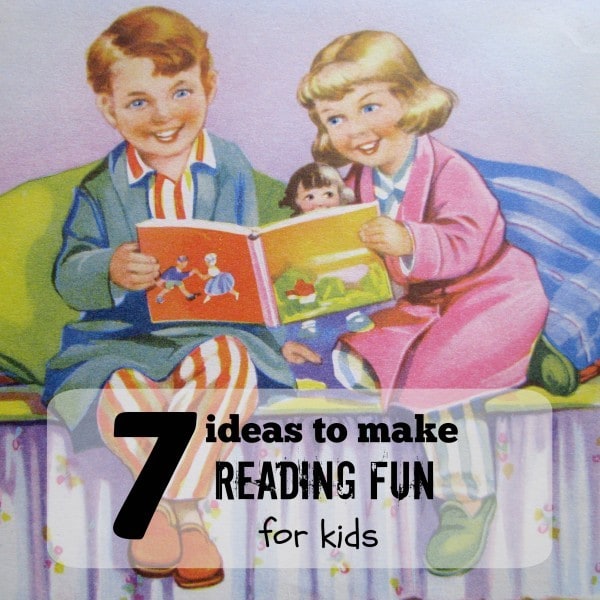Kerry shares ideas on making reading fun for kids in this guest post for the Establish a House series.
shares ideas on making reading fun for kids in this guest post for the Establish a House series.
Our children spend the first two or three years at school learning how to read. After that and for the rest of their lives, they read to learn. For their success, it’s essential that they learn to read well. But what if your child doesn’t like to read? Even if they do read well, you want to continue to make it fun for them. So what can you do?
I’m a mom who’s big on creating fun reading activities for my children. Even before I was married, literacy was my cause. I’ve helped children and adults in Paraguay to begin or advance their reading skills. I’ve helped ESL students, and I’ve tutored children from my son’s classes. He loves to read, just like his mom! So I enjoy sharing our passion with others—especially children.
In case you’re tapped out of ideas for helping your children, or children you spend time with, to love reading, I have a few ideas to help you get your creative juices flowing.
- Read in a tent or fort. Children love having a cozy space to snuggle in. Why not add reading to the adventure? Inside or outside, a tent is a fine hideout for reading any story. Sometimes we’ve chosen specific camping stories that we’ve found at the library. Other times, we just read whatever. I say “we” because my husband and I, along with little brother, often join big brother inside the tent too.
- Read to a dog or other pet. We strongly prefer dogs, but any snuggly pet will do. Children can be coaxed to practice read-aloud skills with an attentive pet when they would otherwise resist. Pets don’t judge, and some children find it very comforting and fun to read to Fido or Fluffy. Don’t have a dog or one that will sit still? See if you can borrow a neighbor’s dog, or see if your library offers a program to read to a dog. If all else fails, read to a favorite stuffed animal.
- Practice spelling. Reading is a huge struggle when you haven’t mastered basic reading concepts or spelling. Make practice fun by writing on a window or mirror with window markers. Check out spellingcity.com for a great free program that offers several games. Google kinesthetic spelling activities. For instance, your child could bounce a ball as they spell each letter in a word. Play a game like Quiddler, where you earn points for building words. Youtube has some cute video clips about learning phonemes and other rules of reading. For instance, I have shown Super E and Silent E cartoon clips to my students because so many of them get confused about whether to say the “e” at the end of a word. Just search for reading ideas on Youtube, and you’ll see more than you ever thought existed.
- Read everything.Help your child read the cereal box, the newspaper, a comic book. Use those spare moments at a restaurant while you’re waiting for food. The menu is perfect practice material. The signs at the zoo and everywhere else? Yes, and point out any specific words that you’ve been practicing. Your child will be thrilled to see them in a real-life application.
- Visit the library. Of course, you’ve thought of this idea, but there may be a few available resources there that you haven’t tapped into. In addition to checking out standard books, ask a librarian about other free resources there or in the community. You might try books on tape or music CDs that teaching reading and spelling concepts, and visit storytime and other library programs. Sometimes they’ll have books and a craft or a game. You never know which combination might spark an interest for your young reader.
- Use your phone and other electronic devices. Visit the app store and download spelling and book apps. Don’t let your phone be a substitute for personal tutoring, but it can be a handy resource for downtime when you can’t give your full attention. I have a nephew who struggled to read. When his mom gave him a Kindle, it opened up his world. Finally, he could adjust text size and lighting that really helped him to better understand the words. Now he loves to read.
- Have dinner or snack with a book. Read with your child If You Give a Mouse a Cookie of If You Give a Moose a Muffin. Then share the snack you just read about. I did this a few times for my first son with friends and cousins when they were little. I also shared the book and snack when it was my son’s turn for preschool treats. His teacher loved my creativity, and it made snacktime extra special. A visit to the library or an online search will turn up a ton of ideas for food and book combos. Off the top of my head: Cloudy with a Chance of Meatballs (spaghetti dinner), Charlie and the Chocolate Factory (we also watched both videos and visited a real chocolate factory). Roald Dahl has a recipe book that features recipes from food mentioned in several of his books. Green Eggs and Ham would be fun for a St. Patty’s day breakfast. Anyway, the options are many. Have fun discovering your favorites.
I hope these ideas help you and your children to love reading. Both of my sons are book enthusiasts, and I am thrilled. The closing lines to one of my favorite poems, by Strickland Gillilan, expresses my sentiments perfectly:
You may have tangible wealth untold;
Caskets of jewels and coffers of gold.
Richer than I you can never be–I had a mother who read to me.
Reader Question: Are you a “reading mother?” What do you do to help your children succeed at reading?
 A devoted reading mother, Kerry has read to her two sons from Day One, just as her mother did for her. Enjoy more ideas for strengthening home and family on her blog at myrandomsampler.com.
A devoted reading mother, Kerry has read to her two sons from Day One, just as her mother did for her. Enjoy more ideas for strengthening home and family on her blog at myrandomsampler.com.

I liked your reading ideas. I used to feel like I had more time to read to my little ones when there were just 2 or 3 toddler/preschoolers. I remember having them bring me a stack of books each and we would read for an hour every day. Now I don’t seem to have the time or energy to read a stack of preschool books for an hour a day. However, I have found that my older kids enjoy reading to the younger ones. It helps the older ones with reading and the younger ones get time with books. We also try to read the scriptures together every day and at night we usually have a chapter book we are reading. We don’t get to it every night, but when we do we always seem to want “one more chapter.”
I’m doing a book club with my homeschooled kids. We get together with another family about once a month to do activities and eat food based on the book we read. This REALLY gets everyone excited about reading! I’ve found this to be very enjoyable even for myself! It’s now my favorite thing we do for school. We are reading The Westing Game right now and even my 4 year old loves it and walks around quoting the book. My 4 year old has so far been the easiest to teach to read- and I think it comes from hearing books read all the time and listening in while I taught his sisters.
Thanks for a well written essay full of great ideas. I am a fan of the read everything moto. That helped keep little bodies still in waiting rooms, restaurants, and myriad other places. I did get some strange stares along the way occasionally when I would be reading signs or other such things out loud and discussing what they meant.
The most important thing an adult can do to raise readers is be a reader! Kids want to do what adults do. The second most important thing is read to your child/children.
I thought this list had some great ideas. Another great idea is ordering a magazine in a child’s name. Kids love getting mail! We really like Ranger Rick at our house–and the Friend, of course. 🙂
I love all of these tips. I love reading to my children. I read to them while they bathe some nights, if we are rushed for time. A friend of mine used to have a designated reading time every afternoon. The TV went off for 30 minutes, and the whole family gathered with books in the living room. In the beginning she read to them. As they grew, everyone, including her, had a book of their own. Often they read past the 30 minute mark while she made dinner. I think it helps, too, if you take books for entertainment whenever there’s going to be something to wait for.